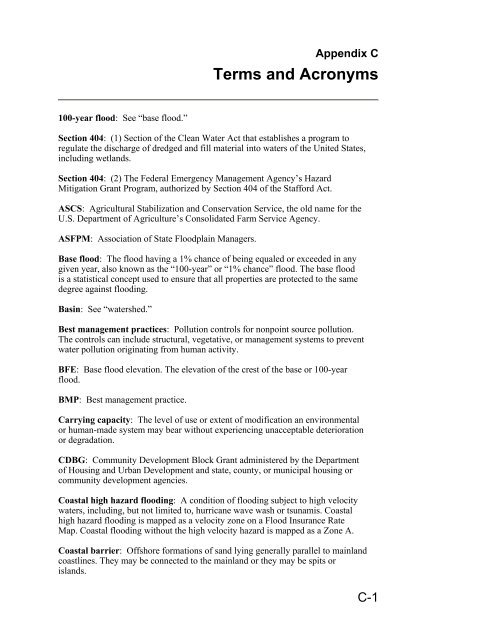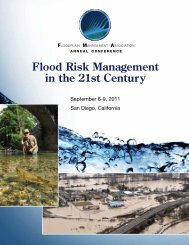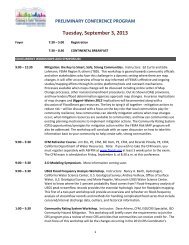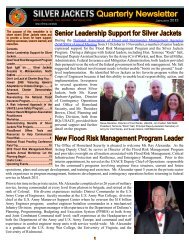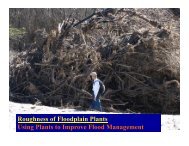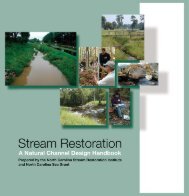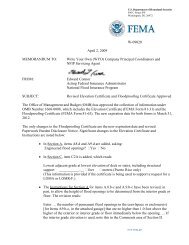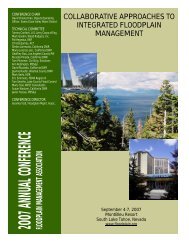Using Multi-Objective Management to Reduce Flood Losses in Your
Using Multi-Objective Management to Reduce Flood Losses in Your
Using Multi-Objective Management to Reduce Flood Losses in Your
Create successful ePaper yourself
Turn your PDF publications into a flip-book with our unique Google optimized e-Paper software.
Appendix C<br />
Terms and Acronyms<br />
100-year flood: See “base flood.”<br />
Section 404: (1) Section of the Clean Water Act that establishes a program <strong>to</strong><br />
regulate the discharge of dredged and fill material <strong>in</strong><strong>to</strong> waters of the United States,<br />
<strong>in</strong>clud<strong>in</strong>g wetlands.<br />
Section 404: (2) The Federal Emergency <strong>Management</strong> Agency’s Hazard<br />
Mitigation Grant Program, authorized by Section 404 of the Stafford Act.<br />
ASCS: Agricultural Stabilization and Conservation Service, the old name for the<br />
U.S. Department of Agriculture’s Consolidated Farm Service Agency.<br />
ASFPM: Association of State <strong>Flood</strong>pla<strong>in</strong> Managers.<br />
Base flood: The flood hav<strong>in</strong>g a 1% chance of be<strong>in</strong>g equaled or exceeded <strong>in</strong> any<br />
given year, also known as the “100-year” or “1% chance” flood. The base flood<br />
is a statistical concept used <strong>to</strong> ensure that all properties are protected <strong>to</strong> the same<br />
degree aga<strong>in</strong>st flood<strong>in</strong>g.<br />
Bas<strong>in</strong>: See “watershed.”<br />
Best management practices: Pollution controls for nonpo<strong>in</strong>t source pollution.<br />
The controls can <strong>in</strong>clude structural, vegetative, or management systems <strong>to</strong> prevent<br />
water pollution orig<strong>in</strong>at<strong>in</strong>g from human activity.<br />
BFE: Base flood elevation. The elevation of the crest of the base or 100-year<br />
flood.<br />
BMP: Best management practice.<br />
Carry<strong>in</strong>g capacity: The level of use or extent of modification an environmental<br />
or human-made system may bear without experienc<strong>in</strong>g unacceptable deterioration<br />
or degradation.<br />
CDBG: Community Development Block Grant adm<strong>in</strong>istered by the Department<br />
of Hous<strong>in</strong>g and Urban Development and state, county, or municipal hous<strong>in</strong>g or<br />
community development agencies.<br />
Coastal high hazard flood<strong>in</strong>g: A condition of flood<strong>in</strong>g subject <strong>to</strong> high velocity<br />
waters, <strong>in</strong>clud<strong>in</strong>g, but not limited <strong>to</strong>, hurricane wave wash or tsunamis. Coastal<br />
high hazard flood<strong>in</strong>g is mapped as a velocity zone on a <strong>Flood</strong> Insurance Rate<br />
Map. Coastal flood<strong>in</strong>g without the high velocity hazard is mapped as a Zone A.<br />
Coastal barrier: Offshore formations of sand ly<strong>in</strong>g generally parallel <strong>to</strong> ma<strong>in</strong>land<br />
coastl<strong>in</strong>es. They may be connected <strong>to</strong> the ma<strong>in</strong>land or they may be spits or<br />
islands.<br />
C-1


